A Complete Strategy for Conducting Dynamic Contact Resistance Measurements on HV Circuit Breakers
Michel Landry, Senior Member, IEEE, Olivier Turcotte, and Fouad Brikci
Abstract—Dynamic contact resistance measurement (DRM) is known as an effective technique for assessing the condition of power circuit-breaker (CB) main contacts and arcing con- tacts. In some SF6 gas CBs, the metallic fluorides (white or gray powder) produced during the arc quenching process mask the actual breaker contact resistance. In this case, the standard DRM method of injecting 100 A dc is no longer applicable. The following paper proposes a complete strategy for conducting DRM on high-voltage CBs based on three relevant parameters: breaker contact speed (low or rated), injected current values (100–2800 A dc), and the presence of metallic fluorides deposited on breaker contacts.
Index Terms—Arc byproducts, circuit breakers (CBs), dynamic contact resistance measurement, metallic fluorides.
- INTRODUCTION
The design of modern high-voltage puffer-type SF gas cir- cuit breakers (CBs) is based on the switching of two par-
allel contact sets. First, the low-resistance silver-plated contacts or the main contacts are specifically designed to carry the load current without any excessive temperature rise. Second, fol- lowing the main contact part, the tungsten–copper arcing con- tacts are finally opened, thus initiating arc quenching and current interruption.
To assess the condition of the breaker contacts, the main con- tact resistance measurement is usually performed. However, the static resistance measured when the breaker remains in a closed position does not give any indication of the condition of the arcing contacts. To evaluate the latter’s condition, an internal inspection can be done, but time-consuming and costly mainte- nance procedures must be followed in order to securely handle the SF gas and arc byproducts. It should be remembered that excessive arcing-contact wear and/or misalignment may result in a decrease in the CB’s breaking capacity.
Dynamic contact resistance measurement (DRM) at rated speed was developed more than ten years ago to assess the con- dition of the arcing contacts without dismantling the breaker. This method is no longer widely used since the interpretation of the resistance curve remains ambiguous. Previously pub- lished test results usually depicted several spikes [1]–[3] in the resistance curve which could be the result of a partial contact part during the contact movement involving high speed and acceleration.
After reviewing the relevant parameters for the low-contact- speed DRM method [4], the paper presents the DRM results for capacitor-bank SF gas HV CBs for which metallic fluorides have a major influence on breaker contact resistance. DRMs at various current levels are also presented. Finally, based on those results, a complete strategy for conducting DRMs on HV CBs is proposed. It is based on three relevant parameters: breaker con- tact speed (low or rated), injected current values (100–2800 A dc), and the presence of metallic fluorides deposited on contacts that could mask the actual contact resistance for some breakers.
2. REVIEW OF THE RELEVANT PARAMETERS FOR PERFORMING DRMS AT LOW CONTACT SPEED
Reference [4] reported that DRMs at low contact speed allow reproducible curves to be obtained which are easy to analyze and interpret. Fig. 1(a) depicts a DRM curve that was recorded at the rated contact speed. Several spikes can be observed. More- over, it is absolutely impossible to identify the main contact part. The presumed main contact part is indicated based on other measurements at low contact speed. It is estimated that this phe- nomenon is caused by the partial contact part due to high contact speed and acceleration during contact movement. At low con- tact speed, the DRM curve [Fig. 1(b)] is far smoother and the main contact part can be easily identified. It must be pointed out that the partial contact part does not occur when high current is interrupted since electromagnetic forces are exerted on the con- tacts, maintaining them together until final contact separation (see Section IV). Therefore, it is assumed that the low-speed DRM more adequately simulates the actual operating conditions of an inservice HV CB.
As documented in [4], when plotting contact resistance as a function of the contact travel, the following vital diagnostic parameters can be extracted:
![]()
• average main contact resistance;
• average arcing contact resistance;
• (in millimeters) main contact wipe;
• (in millimeters) arcing contact wipe;
• ![]() (in millimeters) position of the breaker contacts at the arcing contact part;
(in millimeters) position of the breaker contacts at the arcing contact part;
![]()
![]()
• ![]()
![]() (m mm) area beneath the resistance curve (during
(m mm) area beneath the resistance curve (during ![]() ) as a function of the contact travel.
) as a function of the contact travel.
0885-8977/$25.00 © 2008 IEEE
2 IEEE TRANSACTIONS ON POWER DELIVERY
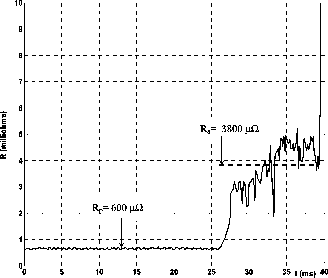
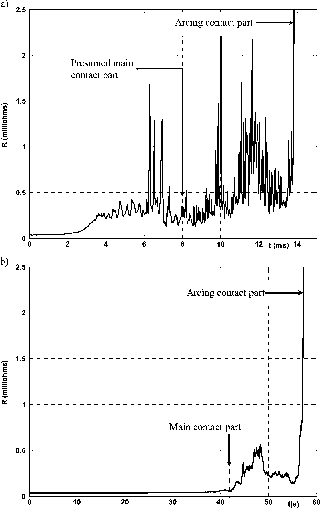
![]()
Fig. 1. Comparison of two consecutive DRMs on the same SF HV CB with defective arcing contacts. (a) At rated speed. (b) At low speed.
5m
![]()
![]()
The product ![]() represents a very useful diagnostic cri- terion, for which a value of 3– mm corresponds to normal arcing contact conditions while a value higher than 10 m mm might indicate defective arcing contacts.
represents a very useful diagnostic cri- terion, for which a value of 3– mm corresponds to normal arcing contact conditions while a value higher than 10 m mm might indicate defective arcing contacts.
DRMs during closing operations are not generally useful since the measurement must be performed during a transient state (i.e., from open to closed contacts). There are two main reasons why the measurement in this condition is impractical.
1) The abrupt resistance variation from infinity (open con- tacts) to the arcing contact resistance is difficult to measure, making the resistance level of the arcing contact difficult to detect.
2) The transient dc current at the moment of the arcing con- tact touch generates undesired noise level and, therefore, jeopardizes the measurement.
III. DRM IN THE PRESENCE OF METALLIC FLUORIDES Metallic fluorides are usually present in the form of a noncon-
![]()
![]()
![]()
ductive dust powder (CuF , AlF , WF , etc.) that is deposited on the breaker contacts. Their influence on contact resistance has already been observed on medium-voltage FB4-type CBs [5] and short-circuit breaking tests have revealed that the presence
Fig. 2. DRM curve obtained for a capacitor-bank SF gas HV CB with in- creased contact resistance caused by deposited metallic fluorides.
![]()
of metallic fluorides does not decrease the breaker’s breaking capacity. In this type of seal-for-life interrupting chamber, the current must circulate through moving roller contacts. It has been observed that arc byproducts adhere to these roller contacts and, therefore, cause an increase in breaker contact resistance. It is also well known that the circulation of a current higher than the rated current results in a decrease in contact resistance [5]–[7]. In [8, Sec. 6.1], the author mentions that high contact resistance will appear when there is no scraping or wiping mo- tion between contacts.
Surprisingly, this phenomenon was observed on capacitor bank CBs that had undergone 4735 operations, which is partic- ularly high. To the author’s knowledge, it was never reported on high-voltage CBs. In fact, as a first check, the substation maintenance crew performed static resistance measurements of the main contacts using conventional equipment injecting 10-A dc current. An extremely high value of the main contact resistance was measured (i.e., in the order of 4500–6000 ![]() ), which could be interpreted as defective contacts.
), which could be interpreted as defective contacts.
Furthermore, it was concluded that the usual measuring equipment at 10–100 A dc is useless in the presence of this type of metallic fluoride.
![]()
![]()
Fig. 2 shows a typical DRM curve at 100 A dc for which the breaker contact resistance is effectively very high (i.e., ![]()
![]() and
and ![]()
![]() ). For the substation maintenance en- gineer, it is a matter of paramount importance to know the actual breaker contact condition of his or her substation CBs. There- fore, a measurement method is needed to determine whether the high resistance value is due to defective contacts or merely caused by the presence of metallic fluorides deposited on the breaker contacts. A measurement method was therefore devel- oped with the aim of avoiding the dismantling of the breaker’s interrupting chambers.
). For the substation maintenance en- gineer, it is a matter of paramount importance to know the actual breaker contact condition of his or her substation CBs. There- fore, a measurement method is needed to determine whether the high resistance value is due to defective contacts or merely caused by the presence of metallic fluorides deposited on the breaker contacts. A measurement method was therefore devel- oped with the aim of avoiding the dismantling of the breaker’s interrupting chambers.
![]()
Fig. 3 illustrates the test setup that was used to perform DRM at 2800 A dc on a capacitor-bank SF gas 120-kV CB. It is comprised of:
LANDRY et al.: COMPLETE STRATEGY FOR CONDUCTING DYNAMIC CONTACT RESISTANCE MEASUREMENTS 3
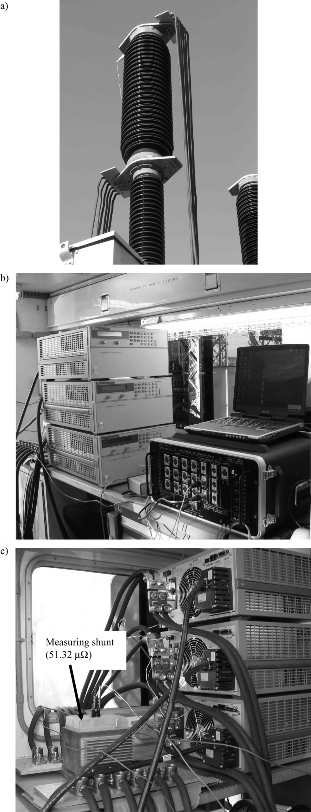
![]()
Fig. 3. Test setup for DRM at 2800 A dc on a capacitor-bank SF gas 120-kV CB. (a) Connections to the breaker terminals. (b) Current sources and data-ac- quisition system. (c) Rear view of the current sources and measuring shunt.
• six 4/0 copper cables for carrying the high dc current from the current source up to the breaker terminals to minimize the voltage drop and not for thermal reasons [Fig. 3(a)];
• three current sources connected in parallel for delivering the measuring current of 2800 A dc [Fig. 3(b)];
• a data-acquisition system [Fig. 3(b)] for recording the rel- evant signals (injected current, voltage across the breaker terminals);
• a measuring shunt (51.32 ![]() ).
).
Due to the time available for executing the test program, the contact travel sensor was not installed. Table I presents a sum- mary of the static and dynamic contact resistance measurements at various currents. With the breaker contacts maintained closed, contact heating intervals (i.e., 1–15 min) were also performed in order to vaporize the deposited metallic fluorides at the actual points of contact. For each phase, the most relevant test results are presented. In view of these results, the following conclusions can be made.
![]()
![]()
• DRMs at 2800 A allow acceptable contact resistance values to be obtained, typically 100 ![]() for the main contacts and 200–300
for the main contacts and 200–300 ![]() for the arcing contacts. Fig. 4 presents such acceptable DRM curves for the three phases of the tested breaker. For phase B, the DRM curve shows that the arcing contact separation flickers. In fact, the contact resistance reaches a value of more than 2.5 m before collapsing to a value lower than 1 m just be- fore the final arcing contact separation. Among DRMs obtained during consecutive opening operations, it was observed that this behavior may occur a few times, and is most likely influenced by the actual surface shape and roughness of the arcing contacts. While it is an acceptable phenomenon close to final arcing contact separation, it should be emphasized that a similar pattern occurring in the middle of the arcing contact travel would be a clear indication of defective arcing contacts.
for the arcing contacts. Fig. 4 presents such acceptable DRM curves for the three phases of the tested breaker. For phase B, the DRM curve shows that the arcing contact separation flickers. In fact, the contact resistance reaches a value of more than 2.5 m before collapsing to a value lower than 1 m just be- fore the final arcing contact separation. Among DRMs obtained during consecutive opening operations, it was observed that this behavior may occur a few times, and is most likely influenced by the actual surface shape and roughness of the arcing contacts. While it is an acceptable phenomenon close to final arcing contact separation, it should be emphasized that a similar pattern occurring in the middle of the arcing contact travel would be a clear indication of defective arcing contacts.
• Metallic fluorides deposited on contacts mask the actual value of the breaker main contacts and arcing contacts. At 100 A, the main contact resistance is extremely high: 863, 546, and 654 ![]() for phases A, B, and C, respectively.
for phases A, B, and C, respectively.
• Current amplitudes of 1000 and 2000 A are not high enough for the metallic fluorides to decompose; to obtain acceptable contact resistance values, a current amplitude of 2800 A was required.
• To reduce the main contact resistance close to 100 ![]() , a contact heating interval of at least 15 min. at 2800 A was required.
, a contact heating interval of at least 15 min. at 2800 A was required.
• For the arcing contacts, several DRMs at 2800 A during opening operations were required to reduce the arcing contact resistance to an acceptable level (i.e., at values of 200–300 ![]() ).
).
IV. DRM IN THE MEDIUM-CURRENT RANGE
A. Reasons for Performing DRMs in a Medium-Current Range
Performing DRMs at low contact speed and with an injected current of 100 A dc has the clear advantage of the resistance curve being noiseless [Fig. 1(b)] (i.e., there is no partial con- tact separation during contact movement). However, for some breaker mechanisms, the method is intrusive since some adjust- ments of the operating mechanism are required for low-speed breaker operation. There is a potential risk of damaging the
4 IEEE TRANSACTIONS ON POWER DELIVERY
TABLE I
![]()
SUMMARY OF STATIC MEASUREMENTS AND DRMS PERFORMED AT VARIOUS CURRENTS ON A CAPACITOR-BANK SF GAS 120-kV CB (THE TEST RESULTS ARE PRESENTED IN THE ORDER OF THE TEST SEQUENCE)
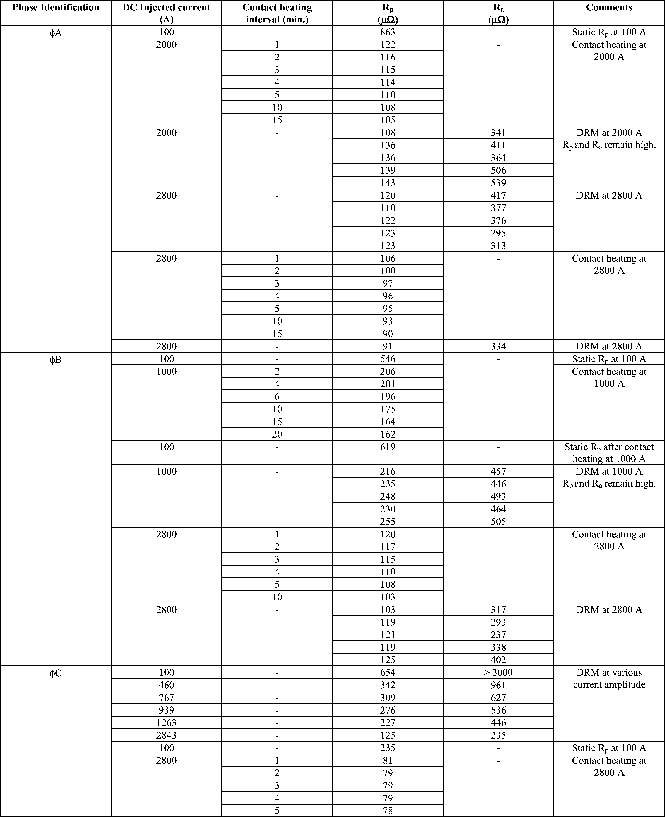
operating mechanism when restoring it back in service. For these breakers, another strategy was successfully used which
consists in performing the DRMs at rated opening speed with an injected current of at least 700 A.
LANDRY et al.: COMPLETE STRATEGY FOR CONDUCTING DYNAMIC CONTACT RESISTANCE MEASUREMENTS 5
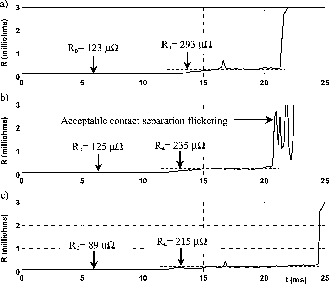
![]()
Fig. 4. DRM curve at 2800 A on a capacitor-bank SF gas 120-kV CB. (a) Phase A. (b) Phase B. (c) Phase C.
B. Physics Related to Forces Exerted on the Fixed Contacts
As documented in [9], the contact resistance can be written
as
![]()
![]()
![]()
![]() (1)
(1)
where
![]()
specific resistivity; ![]() contact hardness;
contact hardness;
![]() total force acting on a contact.
total force acting on a contact.
As can be deduced by (1), the contact resistance is inversely proportional to the square root of the contact force ![]() . This force (
. This force (![]() ) acting on a contact [8] is made up of three com- ponents (2): the contact spring force (
) acting on a contact [8] is made up of three com- ponents (2): the contact spring force (![]() ), the attraction force (
), the attraction force (![]() ), and the repulsion force (
), and the repulsion force ( ![]() )
)
![]()
![]()
![]()
![]()
![]() (2)
(2)
![]()
![]()
For an appropriate contact design, the repulsion force is lower than the attraction force. The attraction force increases as the current circulating through the contact becomes greater. Fig. 5 depicts a cross section of a typical fixed contact and moving finger contacts of an SF gas HV CB. The moving contacts com- prise 12 individual fingers. Therefore, the total injected current (I ) is divided into these 12 fingers and, as a result, a current ![]()
![]() circulates in each finger in the same direction. Elec- tromagnetic attraction forces [10] generated by the associated magnetic-field intensity are proportional to the current square and inversely proportional to the distance (d) between fingers, as given in (3). Therefore, these forces tend to pinch the moving finger contacts on the fixed contact, thus reducing the contact
circulates in each finger in the same direction. Elec- tromagnetic attraction forces [10] generated by the associated magnetic-field intensity are proportional to the current square and inversely proportional to the distance (d) between fingers, as given in (3). Therefore, these forces tend to pinch the moving finger contacts on the fixed contact, thus reducing the contact
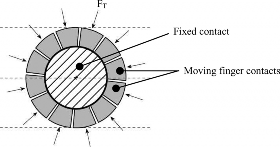
Fig. 5. Schematic of forces exerted on the fixed contact by the moving finger contacts.
resistance as predicted by (1). In addition, these forces signifi- cantly improve the wiping action on the contact surface for re- moving deposited metallic fluorides
![]()
![]()
![]() (3)
(3)
C. Test Results on Several Circuit Breakers
To investigate the influence of the injected current, resistance measurements were performed at rated contact speed on the fol- lowing CBs:
• A1, manufacturer A, hydraulic drive mechanism with en- ergy stored in the disk spring assembly;
• A2, manufacturer A, spring-loaded mechanism;
• B1, manufacturer B, hydraulic drive mechanism with en- ergy stored in nitrogen gas accumulator;
• B2–B4, manufacturer B, spring-loaded mechanism.
![]()
![]()
The injected current was varied from 100 to 875 A. The test results are plotted in Fig. 6(a) for the main contact resistance (R ) and Fig. 6(b) for the arcing contact resistance (R ). Based on these graphs, the following conclusions can be drawn:
![]()
• Except for breaker B1, R with an average value of 25 ![]() is relatively stable as the injected current varies;
is relatively stable as the injected current varies;
• The value of ![]() becomes relatively stable with an injected current of at least 700 A.
becomes relatively stable with an injected current of at least 700 A.
![]()
For breaker A2, Fig. 7 depicts DRM curves at various dc-in- jected currents ranging from 100 to 800 A. Based on this graph, it becomes clear that interpreting the DRM curve at 100 A may lead to a wrong diagnostic, especially for the arcing contact re- sistance (R ) that becomes clearly visible at the main contact separation which occurs at approximately 8 ms. As the injected current increases (100 to 800 A), stabilization of ![]() can be ob- served, as also shown in Fig. 6(b).
can be ob- served, as also shown in Fig. 6(b).
In view of these results, it would be recommended to apply an injected current of at least 700 A when performing DRMs at the rated contact speed.
V. CONCLUSION
This paper demonstrated that DRMs are affected by the fol- lowing parameters:
• breaker contact speed (low or rated);
• presence of metallic fluorides;
• amplitude of the dc injected current.
For some breaker mechanisms, the adjustments required for low-contact speed operations are intrusive. Consequently, DRMs must be performed at rated contact speed despite the
6 IEEE TRANSACTIONS ON POWER DELIVERY
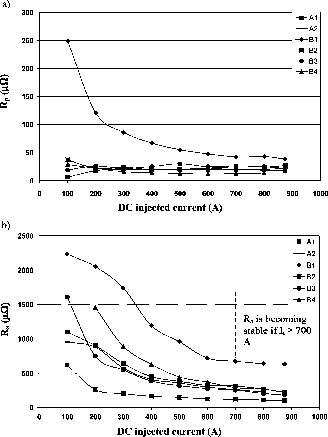
![]()
![]()
Fig. 6. Average breaker contact resistance as a function of the dc injected cur- rent. (a) Main contact resistance (R ). (b) Arcing contact resistance (R ).
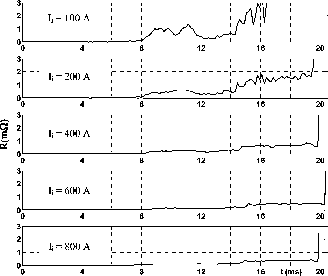
![]()
Fig. 7. DRM curves at the dc injected currents (I ) ranging from 100 to 800 A.
undeniable advantages of low-contact-speed DRMs. Metallic fluorides deposited on the contact surface mask the actual value of the breaker contact resistance. In this particular case, conventional static measurements at 10 or 100 A and DRMs at 100 A are totally useless.
Considering all of these parameters and to avoid dismantling the breaker’s interrupting chamber, the following measurement strategy can be advantageously applied:
1) For Breakers Affected by Metallic Fluorides:
• To measure the actual value of the main contact resistance, the breaker contacts in the closed position must be heated with a current of 2800 A for at least 15 min. After this period, the main contact resistance values in the order of
100 ![]() should be obtained.
should be obtained.
• To obtain the actual value of the arcing contact resistance, several DRMs must be performed during opening opera- tions in order to decrease its value to acceptable levels of 200–300 ![]() .
.
2) For Breakers Not Affected by Metallic Fluorides and for Which Low-Speed Operations Can be Easily Performed: For these breakers, DRMs at low contact speed give the best results.
3) For Breakers Not Affected by Metallic Fluorides and for Which Low-Speed Operations Cannot be Performed: For these breakers, DRMs at the rated contact speed should be performed with an injected current of at least 700 A, thus avoiding possible wrong diagnoses about the breaker contact conditions.
For a thorough diagnostic of breaker contact conditions, con- tact travel measurement would be suggested to assess the fol- lowing parameters:
![]()
• rated contact speed, which is a crucial design parameter for SF gas HV CBs;
• arcing contact wear by comparing the actual arcing con- tact wipe to the reference one corresponding to new arcing contacts.
Moreover, the graph of the contact resistance as a function of the contact travel can be plotted to extract the six crucial diagnostic parameters as described in Section II.
Unless appropriate methods are applied for minimizing the risk of magnetizing the current transformers, this technique should be avoided for dead tank CBs with integral bushing current transformers.
ACKNOWLEDGMENT
The authors would like to thank G. Ouellet, P. Norindr, S. Perron, and C. Latour for the measurement program. They would also like to thank P. Boucher, D. Beauregard, and J. Ducharme for efficiently completing the test measurement setup at the substation.
REFERENCES
[1] F. Salamanca, F. Borras, H. Eggert, and W. Steingräber, “Preventive diagnosis on high-voltage circuit breakers,” in Proc. CIGRE Symp., Berlin, Germany, 1993, pp. 120–02.
[2] R. Kumar Tyagi and N. Singh Sodha, “Condition-based maintenance techniques for EHV-class circuit breakers,” presented at the Doble Client Conf., Boston, MA, 2001.
[3] M. Ohlen, B. Dueck, and H. Wernli, in Proc. Dynamic Resistance Measurements—A Tool for Circuit Breaker Diagnostics, Stockholm Power Tech Int. Symp. Electric Power Engineering, Sweden, Jun. 18–22, 1995, vol. 6, pp. 108–113.
[4] M. Landry, A. Mercier, G. Ouellet, C. Rajotte, J. Caron, M. Roy, and F. Brikci, “A new measurement method of the dynamic contact resistance of HV circuit breakers,” in Proc. CIGRE Session, 2004, pp. A3–112.
![]()
[5] M. Landry, J. Caron, G. Ouellet, and R. Bastien, “A new method for measuring the main contact resistance of 25-kV SF Gas FB4-type circuit breakers,” presented at the Circuit Breaker Test Maintenance Conf., Jackson, MS, Sep. 6–8, 1999.
LANDRY et al.: COMPLETE STRATEGY FOR CONDUCTING DYNAMIC CONTACT RESISTANCE MEASUREMENTS 7
![]()
[6] D. Koch and R. Garzon, “Discussion of the Aubrey J. Herry paper: Problem experienced with interrupters in square D FBS 35-kV SF gas circuit breakers and the repair procedures implemented,” presented at the Doble Conf., Boston, MA, 1994.
![]()
[7] W. B. Hanson, “Discussion of the Aubrey J. Herry paper: Problem experienced with interrupters in square D FBS 35-kV SF gas cir- cuit breakers and the repair procedures implemented,” presented at the Doble Conf., Boston, MA, 1994.
[8] R. D. Garzon, “Contact theory,” in High Voltage Circuit Breakers, De- sign and Applications, 2nd ed. New York: Marcel Dekker, 2002, pp. 198–210.
[9] J. Paulke, H. Weichert, and P. Steinhäuser, “Thermal simulation of switchgear,” IEEE Trans. Compon. Packag. Technol., vol. 25, no. 3, pp. 434–439, Sep. 2002.
[10] W. Hayt H, Engineering Electromagnetics, 2nd ed. New York: Mc- Graw-Hill, ch. 8, p. 258.

Michel Landry (S’75–M’77–SM’90) was born in Québec, Canada, on August 23, 1952. He received the B.Sc.A. degree in electrical engineering from Sherbrooke University, Sherbrooke, QC, Canada, in 1975 and the M.Sc. degree in energy from INRS-En- ergie, University of Québec, Montréal, QC, Canada, in 1977.
From 1977 to 1979, he was responsible for testing electrical power apparatus for the high-power labo- ratory at Hydro-Québec’s Research Institute (IREQ). In 1979, he joined the Electrical Equipment Depart-
ment at IREQ and, until 1983, participated in the development of mathemat- ical methods and computer programs for the selection of electrical components for IREQ’s synthetic platform designed to perform synthetic breaking tests ac- cording to IEC and ANSI standards. From 1983 to 1985, he was involved in a research and test program to qualify the required electrical performance of 2-MV air-blast circuit breakers (CBs) for Hydro-Québec’s James Bay Power System. He also contributed to the development of a new postarc technology applied to power CBs. He is now involved in a multitude of research projects related to breaker interrupting performance and inservice condition monitoring for which MONITEQ, an online monitoring system for HV CBs, earned an R&D 100 from the prestigious R&D Magazine. He has authored or coauthored more than 35 international publications.
![]()
Mr. Landry worked on research related to the design of a new SF6 puffer breaker for low-temperature applications ( 50 C) from 1985 to 1990, which earned him the 1991 Méritas prize in Engineering awarded by the Ordre des Ingénieurs du Québec. He earned a prize paper award from the IEEE Power En- gineering Society in 1986. He is member of the Canadian IEC Technical Com- mittee 17 on switchgear, and a registered Professional Engineer in the province of Québec.
Olivier Turcotte was born in Pointe-Claire, QC, Canada, on February 18, 1981. He received the B.Eng. degree in electrical engineering from Sher- brooke University, Sherbrooke, QC, Canada, in 2003. During the last year of his bachelor degree, he completed his specialization in Electrical Energy at the Institute of Electrical Energy Engineering (IGEE), Montreal, QC, Canada.

Since 2004, he has been a Professional Engineer with TransÉnergie Hydro-Québec’s Transmission Division, in the Electrical Equipment Department,
Montreal. He is mainly involved in certification and maintenance of medium- and high-voltage circuit breakers (CBs) and surge arresters. He is also in charge of research-and-development projects on new diagnostic methods for high-voltage CBs.
Mr. Turcotte received the Jean-Jacques Archambault Scholarship awarded by Hydro-Québec.

Fouad Brikci was born in Marrakech, Morocco, on April 20, 1951. He received the M.Sc. degree in electronics, electrotechnics, and automation and the Ph.D. degree in electronics from Bordeaux University, Bordeaux, France, in 1975 and 1977, respectively.
Currently, he is the President of Zensol Automa- tion, Inc., St.-Laurent, QC, one of the leading manu- facturers of circuit-breaker analyzers in the world. He was the first to introduce (on the market) the concept of TRUE computerized test equipment in the field of
circuit-breaker analyzers. As a former university teacher in Ecole Polytech- nique—Algiers, Algeria and CNRS–LAAS Researcher, Toulouse, France, he has developed experience in the fields of electronics, automation, and computer science. Most of his activities focus on the industrial application of computers. His achievements include the development of fully computerized measuring systems for quality control in circuit-breaker manufacturing, laboratories, and maintenance services of electric utilities. He has specialized in circuit-breaker testing since 1990.

